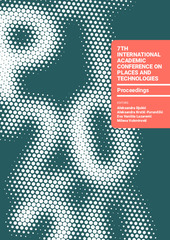Prikaz osnovnih podataka o dokumentu
Application of veneer based panels in Exoskeleton Architecture
| dc.creator | Sokolović, Neda | |
| dc.creator | Kontić, Ana | |
| dc.creator | Josifovski, Andrej | |
| dc.date.accessioned | 2023-11-16T08:55:24Z | |
| dc.date.available | 2023-11-16T08:55:24Z | |
| dc.date.issued | 2020 | |
| dc.identifier.isbn | 978-86-7924-240-2 | |
| dc.identifier.uri | https://raf.arh.bg.ac.rs/handle/123456789/1496 | |
| dc.description.abstract | The development of new materials and technologies is one of the greatest initiator of new architectural thought. Development within the long-standing continuous improvement of wood as material was induced by technological development and new market demands. Good mechanical and physical properties of wood and its easy accessibility, initiated further development and improvement of products based on this material. The aims of this improvement are more rational wood application and improvement of its physical and mechanical properties in regard to monolithic wood. In particular significant are wood-based products made from veneer layers, plywood and laminated veneer lumber (LVL). These materials stand out from other wood-based panel materials due to their mechanical and aesthetic performance. Previous application of veneer-based panels as a structural element in architecture has been implied as secondary or tertiary structural elements which transfer the load to supporting structural members, or to stiffen wooden structures. Recognition a good mechanical property of the material and its advantages as a small self-weight encouraged examining the possibilities of using wood-based panel products as the primary structural support element in exoskeleton structures, i.e. using building envelope as object structure. Application plywood and LVL is research study, so in this paper authors will analyze the possibilities of using these products as an exoskeleton supporting element, through case studies of realized experimental structures. Through research realised structures will be analysed, with a focus on shell structures. They will be evaluated through recognition of its advantages and disadvantages, especially those are directly conditioned by the structural characteristics of the material. Analyses of structures will be done according following criteria: structure design, spatial stability, span constraints, possibilities of loads the structure can support and connections between elements. In order to encourage use of veneer-based panels as load-bearing element in the exoskeleton structure, the paper will set guidelines for further research in this area and will recommend possibilities to improve mechanical characteristics of material. Rationalization of the use of wood-based panels in folded structures will highlight in paper. Forming exoskeleton structure from this material contributes rational use of the structure and raw wood materials saving. | sr |
| dc.language.iso | en | sr |
| dc.publisher | Belgrade : University of Belgrade - Faculty of Architecture | sr |
| dc.rights | openAccess | sr |
| dc.source | Keeping up with technologies to act responsively in urban environment [Elektronski izvor] : conference proceedings / 7th international Academic Conference on Places and Technologies | sr |
| dc.subject | veneer panels | sr |
| dc.subject | plywood | sr |
| dc.subject | еxoskeleton | sr |
| dc.subject | structural elements | sr |
| dc.subject | building envelope as construction | sr |
| dc.title | Application of veneer based panels in Exoskeleton Architecture | sr |
| dc.type | conferenceObject | sr |
| dc.rights.license | ARR | sr |
| dc.rights.holder | University of Belgrade, Faculty of Architecture | sr |
| dc.identifier.doi | 10.18485/arh_pt.2020.7.ch21 | |
| dc.identifier.fulltext | http://raf.arh.bg.ac.rs/bitstream/id/5251/bitstream_5251.pdf | |
| dc.type.version | publishedVersion | sr |

